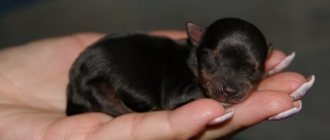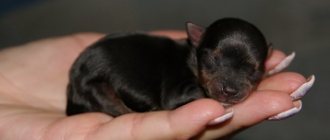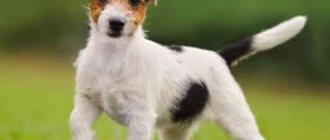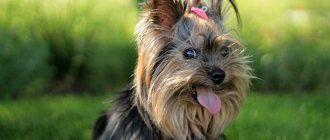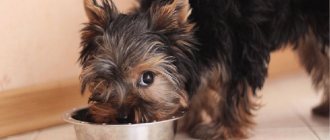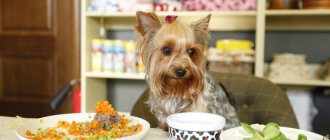York (Yorkshire Terrier) is one of the most famous decorative dogs on the entire planet. They are valued for their energetic character, unquestioning obedience and beautiful appearance. Originally bred for hunting, today it is used only for keeping in an apartment as a pet.
Its charming appearance hides the impulsive nature of the terrier, and its unique coat imposes serious maintenance requirements. In this article we will look at how to properly raise a Yorkshire Terrier, what is needed to maintain the health of the dog.
History of the origin of Yorkshire Terriers
The counties of Yorkshire and Lancashire, located in northern England, are considered the homeland of these dogs. The ancestor of modern Yorkies is the Waterside Terrier, which was popular among peasants. Breeding continued from the 17th to the 19th centuries; Maltese dogs were used for selection - from them the Yorkies inherited their long, silky hair. Thanks to numerous searches for a standard, in addition to the Yorkies, the Manchester Terrier was also bred.
The Yorkshire Terrier became most widespread among weavers working in new mechanized factories. The dog was used as a rat catcher in places where it was impossible to have cats (they spoiled yarn and wool in production). At that time, the dogs weighed 6-7 kg and had a longer and larger body. The Yorkshire Terrier received regulatory recognition in 1886, and a kennel club was organized 20 years later. The first representative appeared in Russia in 1971; today about 75 nurseries are registered throughout the country.
Yorkshire Terrier - description of the breed
The Yorkshire Terrier is one of the smallest dogs, their weight should not exceed 3.2 kg. Externally, it is distinguished by long hair, which should fall completely straight down the sides of the body. A healthy dog normally has not only compact size, but also graceful posture. The Yorkie's body should be strong and athletic, especially if the animal has systematic physical activity. Yorkshire terriers today are bred for decorative purposes; over many years of crossing, they have practically lost their hunting instincts, but they have retained the energy and curiosity inherent in the entire group.
Standard
Dog training standards were adopted in 1954 and have remained virtually unchanged to date. According to accepted rules, the size of a dog is limited only by the upper limit; there are no minimum requirements for weight and height. Basic criteria for assessing this breed:
Frame:
- The Yorkshire Terrier's body is very compact; its height should not exceed 20 cm.
- The loin is strong and developed, with convex ribs on the chest.
- The maximum weight is 3.2 kg; too small or large representatives are a defect, despite the popularity of Yorkshire terriers of non-standard size.
Head:
- The skull is small and flat, no convexity or visible roundness is allowed.
- The tip of the nose is black, the jaws should have a regular scissor bite.
- The eyes are medium in size, dark and have an intelligent expression.
- The ears are small and should be in a V-shaped position; lop-eared individuals are discarded.
- The length of the muzzle is 1/3 of the head; the ears are set high and should not appear protruding.
Limbs:
- The front legs should be straight and have well-developed hair.
- The ends of the hair have a lighter shade than the roots; red-brown color above the elbows is not allowed.
- The hind legs are visually located at a right angle, and are also covered with a large layer of hair.
- The paws are rounded, the claws are black.
Tail:
- It is small in size and has well-developed fur on all surfaces.
- According to the old standard, it had to be docked; today this procedure is prohibited in all European countries.
Wool:
- The Yorkshire Terrier is a long-haired breed with no undercoat.
- Its structure resembles human hair and practically does not fall out.
- On the body, the coat should be completely straight, shiny and silky.
- The greatest length is on the sides of the body and head.
- According to the standard, the coat should have a golden-brown-gray color; in some parts of the body, silver, black and blue shades are allowed.
- Bald individuals and dogs with excessively curly hair are not allowed.
Yorkshire terriers are displayed on the table - this allows you to evaluate the animal’s body and identify the presence of breed defects. If you plan to participate in competitions, then your Yorkie requires careful care and regular physical activity - this allows you to maintain an athletic body shape.
Colors
According to the accepted standard, the Yorkshire Terrier must have a two-tone color - a combination of grayish-blue and reddish-brown shades. At the same time, on the head and neck there is a more saturated color, and on the chest and lower parts of the limbs a reddish-ashy tint is possible.
Many varieties of the breed have been developed, differing in coat color. However, not all of them are accepted by the standard and are allowed to participate in exhibitions. For example, marbled, monochrome black and white Yorkshire terriers, chocolate and completely red ones were bred.
Useful tips
As for haircuts at home, the owner should remember some aspects:
- It is recommended to restrain the dog so that it does not accidentally get hurt during haircuts. For the first time (if you can’t do it alone), you should ask someone to help. The animal must be washed before and after grooming. Using a machine on dirty wool leads to damage to the instrument;
- When using a hair dryer, you should turn it on at the lowest power and do not bring it close to your Yorkie, so as not to burn your pet;
- the first time, when cutting your hair yourself, it is not always possible to do everything evenly and perfectly, and if the face turns out to be very short, then it is not recommended to cut everything to zero. The terrier's coat grows quickly, and very soon the necessary adjustments can be made;
- when training a dog for hygiene procedures, the owner is advised to talk kindly to the pet, encourage calm behavior with treats, so that the dog remembers that the person will not do anything terrible;
- Before cutting, your Yorkie should be placed on a special bedding that will prevent the paws from slipping on the smooth surface on which the procedure is being carried out. You can purchase such a useful item in a specialized store or use an existing rubber bathroom mat;
- It is best to organize a haircut in cotton clothes to prevent electronization of the coat.
Varieties of Yorkshire Terriers
Due to their high decorative value, many varieties have been bred. They differ only in coat color. The most famous of them:
- Beaver . Brought out at the end of the 20th century. He is distinguished by his friendly character and ability to learn. The body combines white and black or blue and white. Golden spots are allowed on the head. Brown pigmentation is possible on the nose, paws and eyelids.
- Biro . The breed variety was created in 2004, when an unusual kitten was discovered in a litter of Biewer Yorkies. The color is tricolor – brown-white-fawn.
- Goldust . Representatives are native to Germany, officially registered in 2007. This variety of Yorkshire is distinguished by a single-colored golden coat.
- Chocolate Yorkie . The main feature of this species is the uniform brown-chocolate shade of the coat. The branch is still not recognized by the breed standard.
Read: Biewer York – decorative black and white terrier
In recent years, the so-called baby-face Yorkshire terriers have been gaining popularity. They are distinguished by a short snout and large eyes, which gives them a childlike appearance. The variety appeared as a result of a genetic mutation; changes in the skull lead not only to a touching appearance, but also to numerous problems with the respiratory system.
Such dogs suffer from congenital chronic inflammation of the eyes, narrowing of the lacrimal duct and constant snoring. Baby face and mini Yorkies are not recognized by the canine association standard, and breeding such dogs is dangerous for the further development of the breed.
General information
Description of the breed. The FCI has not given public recognition to the Biewer as an independent breed. However, dogs have their own specific external features:
Coat color: black-white-golden, white-golden-blue, black and white. The main nuance is the white limbs, sternum and tummy. Reddish specks in the color scheme are not permissible. The content of the coat is uniform, long, and does not curl. There is no undercoat.
The size is twenty-two centimeters (bitches are five centimeters higher than males). Weight category - up to three kilograms (knots are five hundred grams heavier).
The head is proportionate, rounded. The frontal part is flat. The muzzle passes from the forehead at approximately a ninety-degree angle. The buccal lobe is paved with long hair. The lips are tight and do not droop. The upper jaw is slightly longer than the lower jaw. It gives the impression of a constant smile. The nose is large, the same black color. Slightly turned up towards the top.
- The eyes are slightly protruding, round in shape, and set wide apart. The sclera is transparent. The iris is brown in color.
- The teeth are small, even, white. Crooked teeth are unacceptable. A scissor bite is preferred.
- The configuration of the ears is similar to an equilateral triangle. They are standing. They are located high, although due to the thick fur, it seems the opposite.
- The body is rectangular. Long, vertically curved neck. The back is flat. The chest is deep, but narrow.
- The paws are smooth, powerful, the articular part is well developed. The physique is muscular. The claws are small, smooth, white or black.
- The tail is set high, completely covered with long, straight, soft fur. You can't buy it under any circumstances!
Important! Biewer Yorkies are endowed with the following specificity - they change color. Lightens by the age of one year. Changes are possible by the age of three. It turns out that the black wool turns into blue, the red color lightens to beige.
The Biewer Yorkshire Terrier is a long-lived breed. With appropriate maintenance, the right diet and loving feelings from the owner, a puppy can live for about fifteen years.
Children have inherited and acquired diseases:
- - vascular liver disease - signs - convulsions and vomiting non-stop. Surgery is required.
- - acute pancreatitis - unhealthy diet. This is where the educational process of dental problems begins.
- - broken limbs.
- - ophthalmological problems due to long bangs that block the view.
In the Russian Federation, Biewer Yorkies are very common in Moscow and St. Petersburg. Gradually he captivates other subjects. What goal does the owner pursue when thinking about the baby? Participation in exhibition sessions means purchasing only in a nursery, where all the required information about a given individual will be obtained. Price - fifty - sixty thousand rubles.
Buying “for yourself” - private advertisements or pet market. The most important condition, of course, is the health and activity of the pet. An excellent period for sale is three to four months of age. Price - fifteen - twenty thousand rubles.
It is definitely worth reading the reviews before purchasing. The lucky owners talk about the dogs’ good character, playful mood, curiosity, balance. They will be a wonderful gift for children and single people.
Character and behavioral characteristics of Yorkshire terriers
Over many years of breeding, Yorkshire terriers have retained the character traits inherent in all classic terriers - courage, activity and curiosity. The dog treats people kindly and is completely devoted to its owner. Attitudes towards other animals may vary depending on temperament. Impulsive pets retain their hunting instincts - they happily attack birds and small rodents.
Yorkshire Terriers need constant attention; without a person they become apathetic and lethargic. The pet can spend the whole day next to its owner and loves to sleep on the sofa or in their arms. He feels the mood perfectly and can empathize.
On the street, Yorkshire terriers love active games and can chase a ball or a sunbeam for a long time. The remaining hunting instinct can be dangerous; in pursuit of small rodents, dogs of this breed get hit by a car and injure their limbs. Yorkshire Terriers can eat bugs and injured rats and mice, which can result in stomach upset.
Raising and training Yorkshire terriers
Read: How to quickly train a Yorkshire Terrier to use the toilet in the house
Despite their decorative nature, Yorkshire terriers need regular intellectual and physical exercise. The dog is easy to train, starting from puppyhood. Teaching commands is important - it allows you to achieve complete control in difficult situations when you need to call or stop an active pet.
The Yorkshire Terrier needs to be raised in a demanding manner, but one should not be aggressive - the dog can start peeing and trembling at the slightest danger. She feels emotions and can become mischievous and resist, which complicates the lessons. Be sure to teach your Yorkie the commands “near”, “to me” and “place” - this will simplify further interaction.
In training, it is recommended to give preference to positive reinforcement; Yorkshire terriers do not respond well to negative stimuli. These dogs learn new skills well while playing - this form of training is best suited for Yorkies.
Due to the small size of the dog, some owners train Yorkshire terriers to use the indoor toilet (for example, in a litter box), which is not recommended. The dog needs regular exercise and walks in the fresh air, which has a beneficial effect on health.
How to cut a Yorkie, what haircut to choose
There are a huge number of options for how to trim a terrier, the most common are the following:
- Hygienic.
- Classic (standard).
- Model.
It is up to the owner to decide exactly how to trim the pet, but one should not forget about the dog’s needs. Exhibition animals must look presentable, and therefore it is not possible to get away with a hygienic option. If the terrier is simply a pet, then it is enough to regularly update the above option, and not resort to long and exhausting procedures.
Diseases of Yorkshire Terriers
Read: When a Yorkshire Terrier's ears stand up
Yorkshire Terriers are prone to genetic and acquired diseases. Many representatives of this breed have had congenital hypoglycemia (low blood sugar) since childhood; this can be determined by apathy, convulsions and a decrease in body temperature. If measures are not taken in time, the puppy may fall into a coma.
Read: What vaccinations are necessary for a Yorkshire Terrier
Other typical diseases:
- oncological diseases - a particularly high risk of cancer is observed in older individuals (after 11 years);
- due to fragile bones, the chances of diseases of the musculoskeletal system and joint problems in old age increase;
- neurodermatitis usually appears in Yorkshire terriers with an unstable psyche, expressed in the form of hair loss throughout the body, the appearance of itchy formations on the skin;
- Perthes disease is deformation or destruction of the bone of the femoral neck, but there is no inflammation during the development of the pathology. Typically appears in puppies before 5 months of age, causing lifelong lameness;
- Various dental pathologies appear against the background of a constant calcium deficiency, which is inherent in all dwarf breeds.
Read: Peculiarities of teeth change in the Yorkshire Terrier
Cryptorchidism is often diagnosed in Yorkshire Terriers when one or two testicles do not move into the scrotum during maturation. The disease can only be treated surgically. In addition, the breed is prone to distichiasis, which is the formation of an additional row of eyelashes. If you notice one or more alarming symptoms in your pet, you should contact your veterinarian as soon as possible. Early diagnosis allows you to prescribe more effective treatment and reduce the risk of serious complications.
Mini Yorkie
The main feature of mini Yorkies is their miniature size . They weigh about 2 kg .
This causes some difficulties in keeping and caring for such pets:
- they must be constantly monitored and should not be left on beds, sofas and other surfaces elevated above the floor - the dog may fall and damage the bones;
- You should not get a Mini Yorkie if there is a child at home, as children often do not calculate their strength when playing with a pet and can damage the musculoskeletal system;
- There are some difficulties in breeding the breed, so if you are not a professional, then you should not do it.
Important! If you decide to purchase a mini Yorkie, then buy a puppy only from trusted pets. Some dog breeders, in order to breed this subspecies, feed the puppies poorly or do not properly monitor their health.
Interestingly, these are not the smallest representatives of the breed! There are also so-called “micro-Yorks” or “super-mini” , which weigh about one and a half kilograms or even less .
Such small dogs have health problems , most often with the musculoskeletal system . In addition, they live shorter than standard Yorkies.
Baby - face Yorkshire terrier
The peculiarity of this subspecies is that the muzzle does not meet the standards of the Yorkshire Terrier breed.
Here's what it is:
- the head is round in shape;
- the muzzle is shorter than that of a traditional Yorkie;
- ears are below forehead level;
- the eyes are large, protruding, which makes the look seem surprised, a little like a doll’s eyes;
- upturned nose
Thanks to this, the muzzle looks very cute, hence the name: baby face, because the muzzle resembles the expression of a child, a doll. However, these features cause specific health problems, for example:
- chronic conjunctivitis;
- frequent eye injuries (due to bulge);
- teeth often fall out (so you have to carefully monitor them);
- snoring and grunting (due to improper placement of the nasopharynx).
You can buy this cute pet only with unlimited attention and care.
Pregnancy
Read: Heat in Yorkshire Terriers: duration, onset symptoms, possible problems
The gestation period lasts up to 56 days from the moment of fertilization. Throughout this period, you should reduce active physical activity and try to reduce the amount of emotional experiences the dog has. You should strengthen your diet, but not increase the calorie content of each serving, and also give additional vitamin supplements required for the development of the fruit. The litter size varies from 3 to 6 puppies.
Read: Yorkshire Terrier pregnancy: duration, course features
Childbirth in Yorkshire terriers is often turbulent, and a number of problems may develop. It is advisable to carry out the process in a clinic or under the guidance of a veterinarian; if it is necessary to preserve the offspring, agree to a caesarean section. In the last stages of pregnancy, it is imperative to include calcium supplements in your diet to strengthen the skeletal system.
Read: Mating Yorkies - features and choice of partner
Yorkies have good maternal instincts, quickly learn a new role and protect their offspring. Puppies develop quickly and become active from the first months of life. Due to weak bones, dogs should be carefully protected; it is advisable to arrange a separate protected place in the house - it is best to purchase a special cage. It is recommended to separate puppies from their mother no earlier than 3 months (newborn puppies cannot be given away), when the first scheduled vaccination can be carried out.
Character and appearance of the terrier
Yorkshire terriers have preserved the features of their distant hunting ancestors. Yorkies are the same brave, curious, tireless dogs. They are characterized by sociability: Yorkshires are ready to spend 24 hours a day with their owner, become attached to him, and are able to sense a person’s psychological state and adapt. Dogs are friendly to strangers and get along with children.
Other personality traits of Yorkies are also attractive. The terrier loves to walk and will become a constant companion for the owner, who will definitely not get bored thanks to the dog’s playfulness and sociability.
Yorkshire Terrier Care
Despite its apparent simplicity, caring for a Yorkshire Terrier is difficult. They need constant attention and protection from external factors, which often cause the death of a dog. Yorkies are great for keeping in an apartment, but for a comfortable life the pet should have its own place, for example, a lounger or a special house. In addition, it is important to place two bowls in the house according to the size of the dog - for food and water (it should be available at all times).
Walks in the fresh air should be constant - they provide the cells with oxygen and also help maintain the dog’s physical shape. Terriers love active games, this can be used as a load. The wool does not have an undercoat; in winter, it is necessary to use special clothing with insulation; due to poor blood circulation, Yorkshire terriers can begin to freeze at fairly low temperatures.
Yorkshire Terrier Grooming
Particular attention should be paid to wool - due to the characteristics of the breed, it is prone to contamination and tangles. To make the dog silky and soft, it is recommended to wash the dog at least once a month, and also regularly comb it with a special comb without sharp elements. The coat starts out curly and then grows back quickly, so grooming is required, especially if you plan to take part in breed shows.
Unlike short-haired and wire-haired breeds, cutting (grooming) with scissors or a clipper is acceptable. Typically, excess hair is removed throughout the entire body, leaving more volume only on the limbs and muzzle. To achieve the standard, it is recommended that you go to a professional groomer for your haircut rather than doing the procedure at home.
Nails should be trimmed every month to prevent them from overgrowing. In addition, it is regularly recommended to trim the hair in the eye area, as hairs can irritate the mucous membranes and lead to the development of conjunctivitis.
Yorkie puppy grooming
If we talk about the full care procedures that a terrier puppy should undergo, they are as follows:
- from the age of five days they begin to cut their claws;
- at thirty days, ear care is added to the first procedure;
- at 1.5 months they begin to trim the fur in the groin area;
- at 4 months the Yorkie is given a hygienic haircut;
- From 6 – 7 months of age you can begin to model wool processing.
Some dog lovers claim that grooming puppies before one year of age spoils the animal's coat, however, this information is not true. Timely hygiene procedures are necessary and necessary. Thanks to such actions, the wool will not fall into tangles, which will not be so easy to get rid of.
If the owner takes his pet to the salon, the person is advised to follow the following rules:
- While the haircut is in progress, the owner needs to go to another room so that the puppy is not distracted by the owner. At this age, Yorkies are very curious, and therefore it will take some time to get used to a new person, but the presence of the owner next to the dog will only be a hindrance;
- an untimely conversation with a dog can result in the animal suddenly reacting to a familiar voice with an unexpected movement, resulting in a high probability of the terrier getting injured from sharp instruments. Even the most professional groomer may be unprepared for the sudden movement of his four-legged client.
Feeding Yorkshire Terriers
Read: What and how to feed a Yorkshire terrier - analysis of diet, choice of food
These dogs have a special attitude towards food. They are not characterized by an insane appetite and gluttony; often food can be in the bowl all the time, and not in portions. You can feed your Yorkshire Terrier natural food or ready-made dry food. It is best to purchase specialized solutions for small breeds - they contain all the necessary micro- and macroelements, and also have a small granule size. If you prefer to use natural food, then various porridges with meat, eggs are suitable, be sure to add fruits and vegetables - they contain a large amount of vitamins. When feeding, you should avoid fatty, fried, smoked and salty foods.
What to feed a Yorkshire Terrier puppy in the first 2 months of life
Puppies open their eyes at the age of a week or one and a half, and then they begin to hear. They can lap from the age of 2-3 weeks , at which time additional food can be introduced , since the mother’s milk may not be enough, and the puppies grow very quickly.
To do this, milk porridge first introduced into the terriers' diet .
When the pet is one month old, they begin to give : lean, finely chopped beef or chicken, eggs, cottage cheese, kefir, boiled vegetables (carrots, beets), water porridge, apples, pumpkin seeds.
At 2 months old, a Yorkie can be given dry food , which must be selected by a veterinarian for this breed, as allergic reactions are possible.
Once the puppies are a month old, you can carefully trim their nails.
Advice! It is also important to maintain the temperature regime (24 - 26 degrees), not to create drafts or heat in the apartment. You need to wipe your Yorkie's eyes with a cotton swab and examine them every morning.
Tips for choosing puppies
Due to the popularity on the market, you can find many advertisements for the sale of Yorkshire terrier puppies. You should only purchase a dog from a trusted breeder; it is better to choose large kennels.
When choosing a pet, you should pay attention to its appearance - carefully examine each limb, body, eyes and ears. There should be no signs of lameness, as well as apathy and depression. A healthy puppy is active, inquisitive and quickly makes contact with humans. The coat should already be straight at this age; it usually has a black tint with golden spots on the surface of the body. Pay attention to the condition of the gums - normally they are colored a rich pink color.
When purchasing, you must comply with all the necessary paper formalities - sign a purchase and sale agreement, receive the puppy’s birth certificate, his passport with all vaccinations and a pedigree certified by the RKF.
Read: How long do Yorkshire terriers live at home?
Cost and where to buy
Prices for puppies are determined by several factors.
Should be considered:
- Place of purchase. In well-known nurseries the cost will be 0 rub. From new breeders you can pick up a dog for 10,000-20,000 rubles.
- Floor. A female Yorkie will cost more than a male of the same breed.
- Number of puppies in the litter. The price of a puppy is 2-3 thousand higher than from a large lambing.
It is best to purchase a dog from nurseries with a good reputation, and not from markets where the conditions for keeping animals are far from ideal.
Expert opinion
Anna Abramenko
An avid dog lover. Experience in veterinary medicine since 2009.
Ask a Question
The breeder must show the buyer the puppy’s parents, provide the necessary documents, answer all questions, and give advice on the care, maintenance, feeding and education of the Yorkie.
Choosing a nickname
Read: Nicknames for Yorkshire Terriers - choose the right one for your pet
The name for the dog should be chosen taking into account its character and behavior. The most popular nicknames for Yorkshire Terriers:
| Boys: | Butch, Black, Argus, Dar, Zhostik, Pencil, Knopik, Rich, Snoop, Tatoshka. |
| Girls: | Alma, Barbie, Denis, Julie, Lyalya, Mushka, Uma, Trisha, Oxy. |
The puppy should be accustomed to its name from the first days of its arrival in the house. This will simplify further contact with your dog and allow you to achieve full interaction.
Owner reviews
Ksenia K.
“We have had a Yorkshire terrier in our family for 10 years. This is a very kind and understanding dog, there have never been any problems. We have already experienced several births, and strong and healthy puppies were always born.”
Victor A.
“My wife and I were looking for a small dog to keep in our apartment. We chose the Yorkie with caution, as they are now being bred a lot. As a result, they chose the male who was the most active among the others. It feels like a very smart and inquisitive dog, but there is a minus – it barks a lot at extraneous sounds.”
Photo and video review
To make a decision about buying a Yorkie, you should look at photos and videos of these cutest creatures.
Pros and cons of Yorkshire Terriers
The dog should be selected based on your own preferences, appearance and health of the breed.
| Pros: | Minuses: |
|
|
A dog's behavior largely depends on proper care. Despite their size, Yorkshire terriers need proper training and education - this allows them to solve many everyday problems.
Similar breeds
Decorative breeds have many common characteristics. The following are considered similar to Yorkshire Terriers:
Pomeranian Spitz
Shih Tzu
Chihuahua
Yorkshire terriers have a unique coat - it differs in length and structure. Like other terriers, they have slightly angular body features, with limbs at right angles. Unlike long-haired Chihuahuas, they have a larger weight and size, as well as color.
Photo of Yorkshire Terrier
Briefly about the main thing
- The Yorkshire Terrier is a decorative breed originally from England. It was originally bred to hunt rats.
- Yorkie weighing up to 3.2 kg. According to the standard, they have a well-built body, long hair, colored in a golden-brown-gray shade.
- Yorkies are active and inquisitive. They get along well with people and are companions.
- These dogs have many hereditary pathologies. You should carefully choose a puppy, giving preference to proven kennels.
Have you had any experience keeping a Yorkshire Terrier? Share your opinion about this breed in the comments.
Interesting facts about mini Yorkies
- Yorkshire terriers, according to statistics from the kennel club, are among the top three most popular breeds.
- The famous actress Audrey Hepburn introduced the Yorkshire people into the starry world. Her dog, Mr. Famous, was co-starred in the film Funny Face.
- Lucy became the smallest service dog in the world. Her height is only 14.5 cm, and her weight is just over 1 kg. The task of a “civil servant” is to lift the spirits of the elderly and disabled.
- Yorkies also proved themselves during the war. Smokey the dog came to the rescue in hospitals, entertaining the wounded. There was even a monument to the dog in the USA.
- Yorkshire terrier Terry has become the mascot of the Great Britain rugby team.
